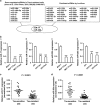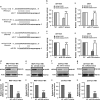Decreased expression of microRNA-17 and microRNA-20b promotes breast cancer resistance to taxol therapy by upregulation of NCOA3
- PMID: 27831559
- PMCID: PMC5260895
- DOI: 10.1038/cddis.2016.367
Decreased expression of microRNA-17 and microRNA-20b promotes breast cancer resistance to taxol therapy by upregulation of NCOA3
Abstract
Chemoresistance is a major obstacle to effective breast cancer chemotherapy. However, the underlying molecular mechanisms remain unclear. In this study, nuclear receptor coactivator 3 (NCOA3) was found to be significantly increased in taxol-resistant breast cancer tissues and cells. Moreover, overexpression of NCOA3 enhanced breast cancer cell resistance to taxol, whereas depletion of NCOA3 decreased taxol resistance. Subsequently, we investigated whether NCOA3 expression was regulated by miRNAs in breast cancer. By bioinformatics prediction in combination with the data of previous report, miR-17 and miR-20b were selected as the potential miRNAs targeting NCOA3. By real-time PCR analysis, we found that miR-17 and miR-20b were significantly reduced in taxol-resistant breast cancer tissues and cells. In addition, we provided some experimental evidences that miR-17 and miR-20b attenuated breast cancer resistance to taxol in vitro and in vivo models. Furthermore, by luciferase reporter assays, we further validated that both miR-17 and miR-20b directly binded the 3'-untranslated region of NCOA3 mRNA and inhibited its expression in breast cancer cells. Finally, both miR-17 and miR-20b levels were found to be significantly negatively correlated with NCOA3 mRNA levels in breast cancer tissues. Together, our results indicated that loss of miR-17 and miR-20b enhanced breast cancer resistance to taxol by upregulating NCOA3 levels. Our study suggested miR-17, miR-20b and NCOA3 may serve as some predictive biomarkers and potential therapeutic targets in taxol-resistant breast cancer treatment.
Figures







Similar articles
-
miRNA-205 targets VEGFA and FGF2 and regulates resistance to chemotherapeutics in breast cancer.Cell Death Dis. 2016 Jun 30;7(6):e2291. doi: 10.1038/cddis.2016.194. Cell Death Dis. 2016. PMID: 27362808 Free PMC article.
-
Downregulation of microRNA-27b-3p enhances tamoxifen resistance in breast cancer by increasing NR5A2 and CREB1 expression.Cell Death Dis. 2016 Nov 3;7(11):e2454. doi: 10.1038/cddis.2016.361. Cell Death Dis. 2016. PMID: 27809310 Free PMC article.
-
miR-218 targets survivin and regulates resistance to chemotherapeutics in breast cancer.Breast Cancer Res Treat. 2015 Jun;151(2):269-80. doi: 10.1007/s10549-015-3372-9. Epub 2015 Apr 22. Breast Cancer Res Treat. 2015. PMID: 25900794
-
MicroRNA-21: a novel therapeutic target in human cancer.Cancer Biol Ther. 2010 Dec 15;10(12):1224-32. doi: 10.4161/cbt.10.12.14252. Epub 2010 Dec 15. Cancer Biol Ther. 2010. PMID: 21139417 Review.
-
The dual role of microRNA (miR)-20b in cancers: Friend or foe?Cell Commun Signal. 2023 Jan 30;21(1):26. doi: 10.1186/s12964-022-01019-7. Cell Commun Signal. 2023. PMID: 36717861 Free PMC article. Review.
Cited by
-
Regulation of breast cancer metastasis signaling by miRNAs.Cancer Metastasis Rev. 2020 Sep;39(3):837-886. doi: 10.1007/s10555-020-09905-7. Cancer Metastasis Rev. 2020. PMID: 32577859 Free PMC article. Review.
-
Clinical Theragnostic Relationship between Drug-Resistance Specific miRNA Expressions, Chemotherapeutic Resistance, and Sensitivity in Breast Cancer: A Systematic Review and Meta-Analysis.Cells. 2019 Oct 14;8(10):1250. doi: 10.3390/cells8101250. Cells. 2019. PMID: 31615089 Free PMC article.
-
Prognostic Value of MicroRNA-20b in Acute Myeloid Leukemia.Front Oncol. 2021 Feb 18;10:553344. doi: 10.3389/fonc.2020.553344. eCollection 2020. Front Oncol. 2021. PMID: 33680910 Free PMC article.
-
The role and mechanisms of action of microRNAs in cancer drug resistance.Clin Epigenetics. 2019 Feb 11;11(1):25. doi: 10.1186/s13148-018-0587-8. Clin Epigenetics. 2019. PMID: 30744689 Free PMC article. Review.
-
The STAT3 inhibitor pimozide impedes cell proliferation and induces ROS generation in human osteosarcoma by suppressing catalase expression.Am J Transl Res. 2017 Aug 15;9(8):3853-3866. eCollection 2017. Am J Transl Res. 2017. PMID: 28861175 Free PMC article.
References
-
- Giannakakou P, Sackett DL, Kang YK, Zhan Z, Buters JT, Fojo T et al. Paclitaxel-resistant human ovarian cancer cells have mutant beta-tubulins that exhibit impaired paclitaxel-driven polymerization. J Biol Chem 1997; 272: 17118–17125. - PubMed
-
- Anzick SL, Kononen J, Walker RL, Azorsa DO, Tanner MM, Guan XY et al. AIB1, a steroid receptor coactivator amplified in breast and ovarian cancer. Science 1997; 277: 965–968. - PubMed
MeSH terms
Substances
LinkOut - more resources
Full Text Sources
Other Literature Sources
Medical
Miscellaneous

